Top News
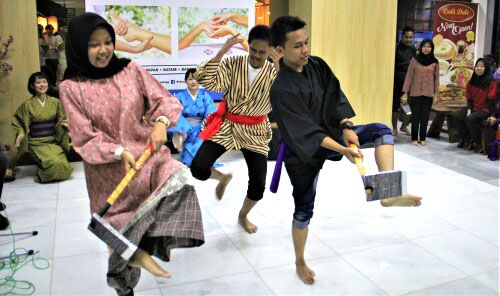
December 1, 2019 Ryukyu Shimpo
By Keiichiro Ono
In support of the reconstruction of Shuri Castle, which recently burned down, over 100 people gathered for a charity event in front of a Japanese restaurant in the Indonesian capital of Jakarta November 29.
Both Japanese people with a connection to Okinawa as well as Indonesians played the sanshin and danced Eisa.
Customers wished for the rapid restoration of the symbol of Okinawa, and donated to a “support fund.”
The host of the even was Ogimi native Akiko Miyagi, 49, an account manager for local business such as Japanese restaurants.
When the news of the fire arrived along with the grief, sympathetic text messages and kind words from patrons started coming in from people who wanted to send their support for the recovery from abroad, and the day after the fire a donation box was placed at the front of the restaurant.
Soon after, members of a sanshin group led by Okinawan natives started discussing a charity even, and the tempo picked up from there.
The Indonesian eisa group “Umaku Eisa Shinka,” and a group primarily comprised of Japanese-Indonesians with an average age of 70 called “Taho Okinawa Eisa” also participated, and the groups performed together.
At the start of the concert, Minami Onuma, 36, from Nishihara gave opening remarks with tears in her eyes, saying, “Every time I think of [the fire] tears come.
Shuri was not only a tourist destination, but was also a center for the arts. Please enjoy the music of the sanshin.”
Over the next hour, the group performed nine pieces including “Asatoya Yunta” and “Ashibina.”
During “Mamidoma,” a dance from Taketomi Island, Indonesians who are studying Japanese also joined in, and after a crash course in the steps were performing the dance to loud applause.
Lastly, performers and audience members joined together in dancing the Kachashi to close the show.
Miyagi said she was filled with emotion that, “the two countries could come together like this.”
The funds collected in the donation box at the front of the store will be donated to Shuri Castle Park via the city of Naha.
(English translation by T&CT and Sam Grieb)
Go To Japanese
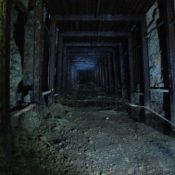
December 1, 2019 Ryukyu Shimpo
While support grows for the reconstruction of Shuri Castle after it was destroyed in a fire, more are also calling for the underground trenches used as the Japanese 32nd Army headquarters to be opened to the public. Eiki Senaha, 91, of Naha, who is the former president of Meio University and decided on the public opening of the trenches as chair of the prefectural 32nd Army Headquarters Trench Preservation and Opening Investigation Committee in 1996, is one such person. “Shuri Castle and the headquarters trenches have an inseparable relationship,” said Senaha, once more emphasizing the necessity of opening the headquarters trenches in conjunction with rebuilding the castle.
Opening of the 32nd Army headquarters trenches was proposed by former senior analyst for the Ministry of Foreign Affairs Masaru Sato in a column for this newspaper, and more are expressing their agreement to the proposal.

Eiki Senaha discussing the necessity of opening the 32nd Army headquarters trenches to the public, on the afternoon of November 29 in Naha
The Okinawa prefectural government, considering the headquarters trenches to be a symbol for the Battle of Okinawa, began a full-scale survey of them in 1993. The Preservation and Opening Investigation Committee, of which Senaha, then a Meio University professor, served as chair, was established in November 1995, and the following year, 1996, the committee decided that the trenches should be opened to the public. Thereafter, a Basic Plan Investigation Committee planned to go so far as opening to the public the room of General Mitsuru Ushijima.
However, from the start there were concerns about the danger of collapse and the extensive costs that would be required to prepare the trenches for opening, and they have yet to be opened to the public. At the time the decision was made, Senaha himself entered the trenches through the 3rd tunnel and observed General Ushijima’s room, reporting that there were hypodermic needles on the ground inside. However, he says that inside “there was water flowing, and I knew that it would be infeasible to open the trenches to the public in that state.”
Shuri Castle has been burned down four times, once of which was in April 1945, right in the middle of the Battle of Okinawa. This was because headquarters trenches were built directly underneath the castle, which had been designated a national treasure, and it was therefore targeted by the U.S. military. “The headquarters trenches are critical in explaining Shuri Castle,” explains Senaha. “They also help us convey the true history of the Battle of Okinawa.”
Hojun Kakinohana, 86, of Naha, who represents the Okinawa Peace Walking Association, a group that explains the Battle of Okinawa through re-experience, says that it should be the national government’s responsibility to prevent the headquarters trenches from collapsing and turn them into a “cornerstone of peace.” “I want people who come to see Shuri Castle to know about them,” says Kakinohana.
■Japanese military bases were targeted by the U.S. military during the Battle of Okinawa
Construction of the 32nd Japanese Army headquarters trenches began in December 1944, with the trenches to serve as the headquarters of the 32nd Army established by the Japanese military as an Okinawa garrison under direct control of the Imperial General Headquarters. The trenches served as a military center for the Japanese military until it retreated to the south in May 1945.
The trenches comprise five tunnels, and include the “rooms” of 32nd Army General Mitsuru Ushijima and Lieutenant General Isamu Cho and an officers’ room. Since the trenches were built directly underneath Shuri Castle, a national treasure, the castle was targeted by the U.S. military in the Battle of Okinawa and was burned to the ground in April 1945. The grounds were the site of a vicious battle between the Japanese and U.S. militaries, and many civilian lives and cultural assets were lost.
An explanation board is posted near the entrance to the first tunnel of the headquarters trenches, near the Sonohyan-utaki stone gate at Shuri Castle, but the prefectural government, in the written explanation prepared by the Explanation Board Installation Investigation Committee in 2012, removed mention therefrom of “comfort women” and massacre of civilians by the Japanese military. There has been disagreement, including some committee members calling for those topics to be reintroduced in the explanation board.
(English translation by T&CT and Sandi Aritza)
Go to Japanese
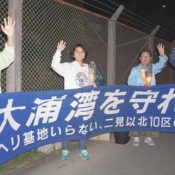
December 2, 2019 Ryukyu Shimpo
By Saki Yoshida
Henoko, Nago City—Every Saturday evening, the Peace Candle lights up near Camp Schwab to protest the construction of a new U.S. military base. November marked the 16th year for the Peace Candle protest, which was started by Takekiyo Toguchi, 63, and his family in 2004. Daughter Kazuki, 17, who has been lighting candles since she was two years old, is now a senior in high school. She’s more passionate than ever: “The environment may have changed, but my desire to protect Okinawa’s future hasn’t changed between now and then.”
Around sunset on November 30, the Toguchi family lit their candles in the occasional chilly winds. They positioned themselves on the sidewalk, holding up a banner and protested: “Protect our beautiful oceans. Stop the new base construction.” The family waved at passing cars, with orange candles in hand. This day, they waved unceasingly for half an hour, along with participants visiting from outside the prefecture.
When the family began the Peace Candle protest, two-year-old Kazuki used to sit on the curb and watch the fluttering candle lights. Now 17, she explained, “Back then, I didn’t understand why the fence was there, and I was curious to go inside. I’ve come to understand that it’s America, in Okinawa.”
Having watched her parents and others wave tirelessly in protest of a new military base construction over the years, Kazuki now envisions a peaceful Okinawa for the next generation of children. The 17-year-old fixed her focus on the future and said, “No base construction. For the future kids of Okinawa.”
(English translation by T&CT and Monica Shingaki)
Go to Japanese
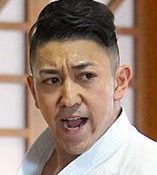
December 1, 2019 Ryukyu Shimpo
Ryo Kiyuna, 29, Ryueiryu-ryuhokai, along with two others, were the first to be selected to represent Japan at the 2020 Tokyo Olympics in the Kata competition for Karate, a sport that was born in Okinawa and will be at the Olympics for the first time, after satisfying the selection criteria set by the Japan Karate Federation (JKF).
He is the first Okinawan native to be selected for the Tokyo Olympics. Additionally, Kiyo Shimizu, 25, Miki House, was selected for the Women’s Kata, and Ken Nishimura, 23, Champ, was selected for the 75 kg division of the Kumite.
The JKF has stipulated that they will focus their selections on the top two athletes in the Work Karate Federation’s 2020 Olympic Rankings, which will be announced January first 2020.
Additionally, if one of the two Karateka create a point differential of 2,000 points or more by Premier League Paris 2020, which will also be held in January, they will make a “tentative offer” to that athlete. The three Karateka selected have already achieved both of these criteria by December 1, with the completion of Premier League Madrid 2019.
All of the Karateka from each country will be selected by April 6 of 2020, based on criteria such as the WKF Olympic ranking. On the same day, the JKF will make their “Official Selections” as well.
Another Okinawa native, Hirokazu Ueyonabaru, 48, was also tentatively offered a spot at the Tokyo Paralympics in the wheelchair race.
(English Translation by T&CT and Sam Grieb)
Go to Japanese

November 28, 2019 Ryukyu Shimpo
The “5th Fatty Pig International Conference” (hosted by the International Pork Research Society), a research conference that presents existing international research results for pork, was held November 27 at the Okinawa Gender Equality Center Tiruru in Naha. Approximately 100 researchers and scholars attended the conference from a number of different countries to present their findings. The participants from Okinawa presented their efforts in preserving and popularizing of “Agu” pork, native to the Ryukyu archipelago.
Until this year, the conference has been hosted in a bi-annual rotation between Spain, home of Iberico pork, and Hungary, home of Mangalica pork, both globally recognized brands. This is the first time the conference has been hosted outside of these two countries, in recognition of Okinawa’s Agu pork production. A welcome reception was held at the Pacific Hotel Okinawa in Naha November 28.
The keynote speech was given by Satoshi Nakamura from the Okinawa Prefectural Livestock Office, where he spoke about the history of Agu pork, as well as their efforts to turn it into a recognized brand.
Yasushi Toyoshima, a researcher at the Okinawa Livestock Research Center, said gave a presentation on the “meat quality and hereditary characteristics of Okinawa Agu.” In research from the same center, they found that Agu had genetic similarities with pigs from China, and they concluded that the pigs’ ancestors came over from China about 600 years ago.
Additionally, there were presentations from researchers from other countries about increases in productivity, veterinary techniques, and processing and distribution techniques.
(English translation by T&CT and Sam Grieb)
Go to Japanese
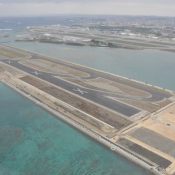
November 26, 2019 Ryukyu Shimpo
Tokyo, November 26—The Ministry of Land, Infrastructure, Transport and Tourism announced this morning that the second runway under construction at Naha Airport will be operational starting March 26, 2020. A new air traffic control tower designed to accompany the addition of the second runway is also under construction, and will be operational January 15, 2020.
The existing runway at Naha Airport is becoming increasingly congested, as it currently operates over 160,000 entries and exits on a runway with a capacity of 135,000. By adding a second runway, the Japanese government has charted a path to boost Naha Airport’s capacity to 240,000.
During the post-cabinet meeting interview the same morning, Minister Kazuyoshi Akaba commented: “We anticipate Naha Airport to serve an even greater role as a connecting hub facilitating the flow of people and goods between Okinawa, other prefectures of Japan and cities abroad. We hope this will contribute to an increase in tourists and enhance convenience.” The minister has recently visited the site, and confirmed the construction work is coming along.
(English translation by T&CT and Monica Shingaki)
Go to Japanese
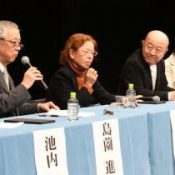
November 22, 2019 Ryukyu Shimpo
On the evening of November 21, a symposium titled “Questioning this nation from Okinawa–peace, the Constitution, and democracy” (sponsored by the Committee of Seven to Appeal for World Peace, co-sponsored by the Ryukyu Shimpo) for investigating the nature of peace was held at the Ryukyu Shimpo Hall in Naha. At the symposium, speakers discussed the opposition of many Okinawans to the new base construction in Henoko, Nago in conjunction with the relocation of U.S. Marine Corps Air Station Futenma and criticized the Japanese government for pushing forward with the construction and running counter to peace-making efforts. The hall was packed with 400 attendees, who listened with rapt attention to the speakers’ words.
Regarding the fact that Okinawa’s base issues are not regarded as national issues, Naoki Prize-winner Kaoru Takamura pointed out that “apathy toward and ignorance about Okinawa, and ignorance of history, pose a major barrier.” University of Tokyo emeritus professor of religious studies Susumu Shimazono said, “forgetting of history and cessation of thought prevent an understanding of Okinawans’ pain and suffering.”
Jinshiro Motoyama, who was representative of the association that worked to bring about the prefectural referendum regarding the Henoko base, said, “The result of the prefectural referendum was trampled upon. Is Japan really a country that values its peace constitution and democracy?” Nagoya University emeritus professor of astrophysics Satoru Ikeuchi said, “The Japanese government alleges to be future-minded, but it has no sense of accountability. We must continue holding it accountable.”
Regarding what Okinawans should do going forward, composer and cultural icon Shinichiro Ikebe called for continued activism, saying, “Things will change eventually. If we keep making efforts and don’t give up, our strength will grow.” Keio University emeritus professor of physics and director of the Committee of Seven Michiji Konuma said, “Looking globally, bases are decreasing continuously.”
Photographer Yoshino Oishi emphasized, “Interacting with the people protesting at Henoko, I felt that continuing such activism is important. If we stop, we would be playing into the hands of the people who want to make war.”
The symposium closed with a chorus of the peace song “Kowashite wa ikenai (we must not break it)” led by Ikebe. Some of the committee members observed the protests in front of the gate to U.S. Military Camp Schwab in Henoko, Nago on the morning of the same day.
(English translation by T&CT and Sandi Aritza)
Go to Japanese

November 24, 2019 Ryukyu Shimpo
The Nirai Kanainu-kai organization (co-represented by Masako Kameya, Takeshi Tamaki, Shisei Toma, and Yasukatsu Matsushima) was launched November 23 to demand the return of remains that had been excavated from graves in Okinawa and Amami by anthropologists for research purposes before World War II.
At a meeting held in Ginowan, the group reported that there were at least 219 remains that were removed, and they confirmed a plan of action for getting them returned.
The information was gathered from documents such as ones from Yasukatsu Matsushima, (Ryukoku University professor), the head plaintiff in the Ryukyu remains return lawsuit filed against Kyoto University.
The group is expanding upon the existing effort to repatriate the remains taken from the Mumujana tomb in Nakijin to include the entire Ryukyu archipelago. Moreover, there is documentation that suggests that there may be over 300 remains that were excavated, and the organization foresees the number of remains they will demand be returned will grow.
The organization is learning from the successes of the Ainu organization Kotan-no-kai, who were able to retrieve similarly excavated remains from Hokkaido University, and in addition to demanding the return of the remains from the former imperial universities that are keeping them, filing freedom of information requests and trying to garner support for their lawsuit.
If the remains are returned, the organization will re-entomb the remains adhering to the proper rituals and ceremonies.
Already, 63 remains that were being kept at Taiwan University were returned to Okinawa in March.
It is believed that Kyoto University is storing at least 26 remains, and they are currently battling with the university to have them returned. As there are also remains that were taken from the Amami region, the “Amami Mishima Cooperation Organization for the return of remains stored at Kyoto University” is demanding their return.
The Nirai Kanainu-kai have also identified remains that were taken by anthropologists from towns such as Nakagusuku, Tomigusuku, an Yonaguni based on documentation, and are requesting the return of the remains to each location.
Professor Matsushima, who joined the meeting via Skype commented, “The remains that were returned from Taiwan University (being stored at the Okinawa Center for Archeological Cultural Assets) are being used for research. In order to request a return that is true to the meaning of the word, we need an organization that can perform the proper rituals.”
(English translation by T&CT and Sam Grieb)
Go to Japanese
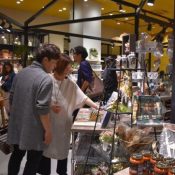
November 23, 2019 Ryukyu Shimpo
Kubota, Okinawa City— On November 22, the Plaza House Shopping Center unveiled its newest additions: Roger’s Food Market, a food hall which features quality delicacies from around the world, and the Cinema Plaza House 1954, a mini-theater.
Plaza House has curated an offering of “relaxed and luxurious” fashion items and lifestyle products. With its newest addition of gastronomy and culture, the shopping center is set to offer all aspects of “clothing, food, home, and play.”
Roger’s Food Market, which is currently soft-opened, boasts 600 square meters of floor space on the ground level. This new addition was made possible by grant aid provided by the Ministry of Economy, Trade and Industry, as part of its support measures of small and medium enterprises.
The food hall features a brown color scheme and offers spices, condiments, desserts and foods. A dining area is provided for customers purchasing the carefully crafted delicacies from the delicatessen or Ebony & Ivory, which offers Asian and Mediterranean cuisine. Customers will also find fresh cuts of meat and fish, a wide array of wines, and Roger’s brand products available exclusively at the Plaza House Shopping Center.
Miyuki Sekinishi, 45, an Okinawa City office worker said, “It feels like I’m on vacation in a foreign country. There are so many fashionable products to choose from, it’s exciting.”
Yoshino Taira, president of Plaza House Inc., alluded to the exotic air of the city and its history, and said: “We are spreading the appeal of the old and new Koza, through gastronomy and fashion.”
The food market is in its soft-open phase until December 4, open 10 a.m. – 9 p.m., and will continue to open its doors at 10 a.m. starting December 5.
(English translation by T&CT and Monica Shingaki)
Go to Japanese
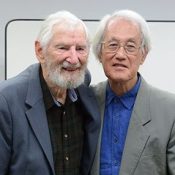
November 21, 2019 Ryukyu Shimpo
William Elder, 92, who was sent as a missionary to the Okinawa Church of Christ by the United Church of Christ Japan from 1966-1969, prior to Okinawa’s reversion to Japan, traveled to Okinawa from Osaka November 20 for a reunion with Pastor Osamu Taira, 87, their first in 50 years. The two reflected on the authoritarian rule of Okinawa by the U.S., and talked about how the new base construction at Henoko, which if being forced through by the government against the wishes of Okinawa shows, “Nothing has changed between back then and now,” expressing their sorrow over the current state of affairs in Okinawa. On November 21, they gave a lecture on “Churches in Okinawa under U.S. rule,” in Nishihara, where they shared their experiences and thoughts.
Taira is well known for the prayer he gave at the ceremony for Ferdinand Thomas Unger’s inauguration as High Commissioner of the Ryukyu Islands, which stated “I pray that the new High Commissioner is the last High Commissioner, and that Okinawa can return to its previous state of normality.” Taira supposedly consulted with Elder prior to the inauguration ceremony. Elder added, “This prayer was not my prayer. It was Mr. Taira’s prayer,” although he said that he agreed with the words Taira used.
The November 20 reunion was on the day that High Commissioner Unger resigned from his post 51 years ago, and the day his successor, Lieutenant General James B. Lampert, took office. After the reunion, the two held a press conference in Ginowan.
Elder said of the continuing base construction, “I don’t think anything has changed from that time (before the reversion),” he said, strained. He continued to keep an eye on Okinawa from mainland Japan after the reversion, however, “When I raised an appeal about the situation in Okinawa on the mainland, it was not understood that Okinawa is discriminated against.”
Taira said, “I thought at the time that reverting Okinawa back to Japan would set things right. My criticism (at the inauguration) was a reflection of that. However, the situation in Okinawa has only gotten worse.”
Elder was visiting Okinawa as part of his research in his role as professor emeritus at the Osaka Jogakuin University, with a plan to gather testimony about churches in Okinawa before the reversion. The lecture on November 21 ran from 7-9 p.m. at the Okinawa Christian University Jerome Auditorium in Nishihara. The lecture was geared towards Christians, but was open to the general public and free admission.
(English translation by T&CT and Sam Grieb)
Go to Japanese

November 22, 2019 Ryukyu Shimpo
On November 2, high-school sophomore student Po-Han Chang won first place in division 1 (non-bilingual division) of the 29th Kyushu Regional English Speech Contest held in Fukuoka. Dreaming of playing in Japan’s national high-school baseball championship known as the koshien, Chang left his home town of Taiwan last spring to attend Okinawa Shogaku High School.
Choosing “what lies beyond new challenges” as the theme of his speech, Chang spoke on studying abroad. The judges favored the incorporation of Chang’s own personal experiences in his speech.
In his oration, Chang shared his experience as an international student at Okinawa Shogaku High School. There were days he found himself wishing to return home to Taiwan, confounded by the linguistic and cultural challenges he faced in the classroom and on the field. However, he was able to overcome these difficulties, focus on baseball practice, and in July, Chang fulfilled his dream of playing in the national koshien championship as a member of the Okinawa Shogaku High School baseball team.
In his speech, titled “Get Out of your Comfort Zone,” Chang underscored the importance of taking on new challenges: “When I left my comfort zone (Taiwan) and tried something new, I was rewarded with major growth and success.”
He commented on winning first place with a sheepish grin, “I managed my busy schedule to practice [the speech], so I felt confident.” Chang revealed his next goals in fluent Japanese, “I want to contribute to the world through sports.”
A strong student and athlete, Chang plans to continue studying English, his favorite subject since he was young, as he completes his high school education with his sights set on attending college in Japan or in the U.S.
(English translation by T&CT and Monica Shingaki)
Go to Japanese












 Webcam(Kokusai Street)
Webcam(Kokusai Street)


